Analyzing Mr. Peter Ling's Case Using the Clinical Reasoning Cycle
VerifiedAdded on 2022/10/09
|10
|2737
|392
Essay
AI Summary
This essay provides a detailed analysis of Mr. Peter Ling's case, applying the clinical reasoning cycle to assess, diagnose, and plan care. The essay begins with an introduction to the importance of clinical reasoning in nursing, highlighting its role in improving patient outcomes. It then progresses through the stages of the clinical reasoning cycle, including patient consideration, information collection, processing of gathered information, identification of nursing problems (pain, obesity, and hypertension), goal setting, action planning, and evaluation. The essay emphasizes the need to address Mr. Ling's hypertension, obesity, and wound care needs. The essay concludes by highlighting the importance of the clinical reasoning cycle in providing quality patient care and reducing potential lawsuits against healthcare institutions. The essay also provides recommendations for interventions, including pain management, obesity management, and hypertension management strategies. The use of cognitive-behavioral therapy is also discussed to improve patient behavior and health status. The essay demonstrates how the clinical reasoning cycle can be effectively used to develop a comprehensive care plan for a patient with multiple health issues.
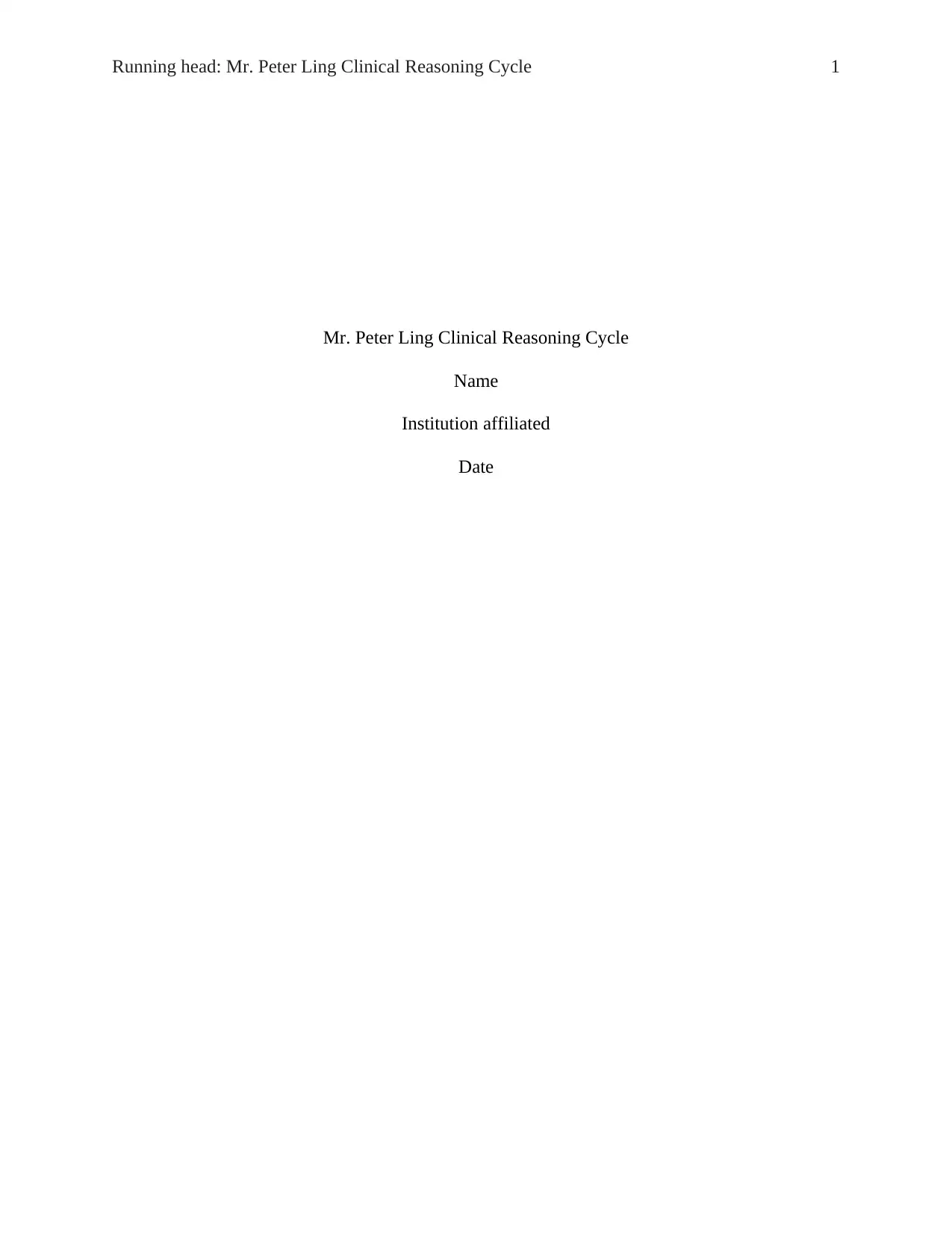
Running head: Mr. Peter Ling Clinical Reasoning Cycle 1
Mr. Peter Ling Clinical Reasoning Cycle
Name
Institution affiliated
Date
Mr. Peter Ling Clinical Reasoning Cycle
Name
Institution affiliated
Date
Paraphrase This Document
Need a fresh take? Get an instant paraphrase of this document with our AI Paraphraser

Mr. Peter Ling Clinical Reasoning Cycle 2
Introduction
Positive reasoning skills have always ensured a constructive effect on a the outcome of
the patient. However, nurses with poor reasoning skills have a high probability of failing to
detect potential deterioration from drug-body interaction or standard 'failure' rescue. According
to Levette-Jones and Burgeois (2015), these issues have to lead to health care complains in the
ever-increasing population of seniors. The main reasons for adverse patient outcomes in most of
healthcare provider institutions include; failure to administer appropriate medication, failure to
diagnose appropriately, and inappropriate management strategies of the presented situation
(Makary and Daniel, 2016). These issues are all related to poor reasoning skills due to that; the
education system should promote proper recognition and care of patients whose conditions are
worsening (Liaw et al., 2014).
Additionally, nursing practitioners should be able to utilize various communication
channels and collaboration of inter-professional teams to ensure accurate and quality service
delivery to patients (Turrentine et al., 2016). By implementing the clinical reasoning cycle, these
goals can be achieved (Levette-Jones and Bourgeois, 2014). This essay utilizes clinical reasoning
cycle in reviewing and planning care for Mr.Peter Ling.
Patient consideration
The patient consideration is the initial stage in clinical reasoning cycle. The operating
nurse comes across the patient and takes care of the patient to promote familiarization with care
(Levett-Jones et al., 2014). It may be through handover or notice when the patient arrives at the
hospital or ward (Wood et al., 2015). Therefore, while conducting the first impression on Mr.
Ling, it is essential to note that prior preconceptions and assumptions may influence some of the
Introduction
Positive reasoning skills have always ensured a constructive effect on a the outcome of
the patient. However, nurses with poor reasoning skills have a high probability of failing to
detect potential deterioration from drug-body interaction or standard 'failure' rescue. According
to Levette-Jones and Burgeois (2015), these issues have to lead to health care complains in the
ever-increasing population of seniors. The main reasons for adverse patient outcomes in most of
healthcare provider institutions include; failure to administer appropriate medication, failure to
diagnose appropriately, and inappropriate management strategies of the presented situation
(Makary and Daniel, 2016). These issues are all related to poor reasoning skills due to that; the
education system should promote proper recognition and care of patients whose conditions are
worsening (Liaw et al., 2014).
Additionally, nursing practitioners should be able to utilize various communication
channels and collaboration of inter-professional teams to ensure accurate and quality service
delivery to patients (Turrentine et al., 2016). By implementing the clinical reasoning cycle, these
goals can be achieved (Levette-Jones and Bourgeois, 2014). This essay utilizes clinical reasoning
cycle in reviewing and planning care for Mr.Peter Ling.
Patient consideration
The patient consideration is the initial stage in clinical reasoning cycle. The operating
nurse comes across the patient and takes care of the patient to promote familiarization with care
(Levett-Jones et al., 2014). It may be through handover or notice when the patient arrives at the
hospital or ward (Wood et al., 2015). Therefore, while conducting the first impression on Mr.
Ling, it is essential to note that prior preconceptions and assumptions may influence some of the
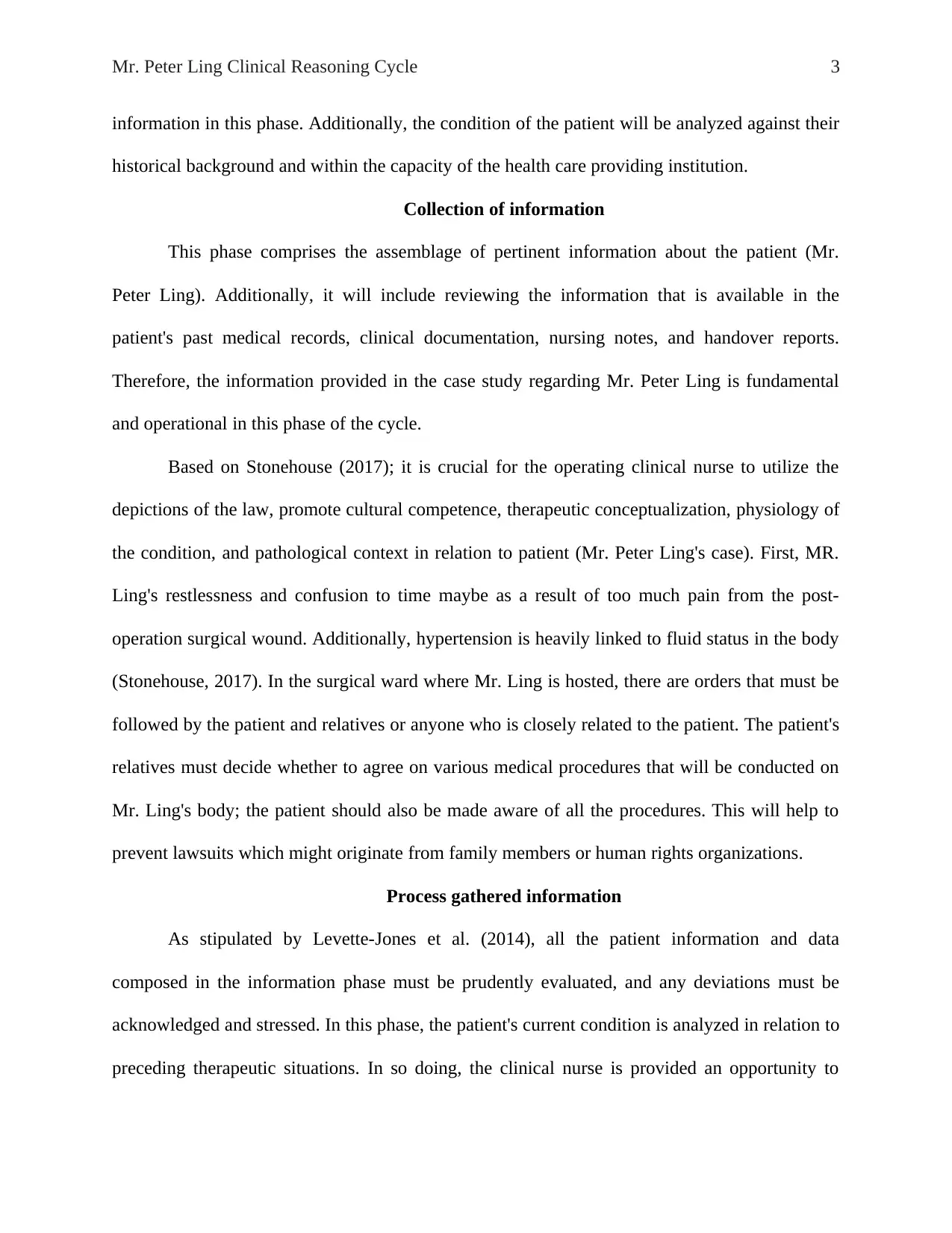
Mr. Peter Ling Clinical Reasoning Cycle 3
information in this phase. Additionally, the condition of the patient will be analyzed against their
historical background and within the capacity of the health care providing institution.
Collection of information
This phase comprises the assemblage of pertinent information about the patient (Mr.
Peter Ling). Additionally, it will include reviewing the information that is available in the
patient's past medical records, clinical documentation, nursing notes, and handover reports.
Therefore, the information provided in the case study regarding Mr. Peter Ling is fundamental
and operational in this phase of the cycle.
Based on Stonehouse (2017); it is crucial for the operating clinical nurse to utilize the
depictions of the law, promote cultural competence, therapeutic conceptualization, physiology of
the condition, and pathological context in relation to patient (Mr. Peter Ling's case). First, MR.
Ling's restlessness and confusion to time maybe as a result of too much pain from the post-
operation surgical wound. Additionally, hypertension is heavily linked to fluid status in the body
(Stonehouse, 2017). In the surgical ward where Mr. Ling is hosted, there are orders that must be
followed by the patient and relatives or anyone who is closely related to the patient. The patient's
relatives must decide whether to agree on various medical procedures that will be conducted on
Mr. Ling's body; the patient should also be made aware of all the procedures. This will help to
prevent lawsuits which might originate from family members or human rights organizations.
Process gathered information
As stipulated by Levette-Jones et al. (2014), all the patient information and data
composed in the information phase must be prudently evaluated, and any deviations must be
acknowledged and stressed. In this phase, the patient's current condition is analyzed in relation to
preceding therapeutic situations. In so doing, the clinical nurse is provided an opportunity to
information in this phase. Additionally, the condition of the patient will be analyzed against their
historical background and within the capacity of the health care providing institution.
Collection of information
This phase comprises the assemblage of pertinent information about the patient (Mr.
Peter Ling). Additionally, it will include reviewing the information that is available in the
patient's past medical records, clinical documentation, nursing notes, and handover reports.
Therefore, the information provided in the case study regarding Mr. Peter Ling is fundamental
and operational in this phase of the cycle.
Based on Stonehouse (2017); it is crucial for the operating clinical nurse to utilize the
depictions of the law, promote cultural competence, therapeutic conceptualization, physiology of
the condition, and pathological context in relation to patient (Mr. Peter Ling's case). First, MR.
Ling's restlessness and confusion to time maybe as a result of too much pain from the post-
operation surgical wound. Additionally, hypertension is heavily linked to fluid status in the body
(Stonehouse, 2017). In the surgical ward where Mr. Ling is hosted, there are orders that must be
followed by the patient and relatives or anyone who is closely related to the patient. The patient's
relatives must decide whether to agree on various medical procedures that will be conducted on
Mr. Ling's body; the patient should also be made aware of all the procedures. This will help to
prevent lawsuits which might originate from family members or human rights organizations.
Process gathered information
As stipulated by Levette-Jones et al. (2014), all the patient information and data
composed in the information phase must be prudently evaluated, and any deviations must be
acknowledged and stressed. In this phase, the patient's current condition is analyzed in relation to
preceding therapeutic situations. In so doing, the clinical nurse is provided an opportunity to
⊘ This is a preview!⊘
Do you want full access?
Subscribe today to unlock all pages.

Trusted by 1+ million students worldwide
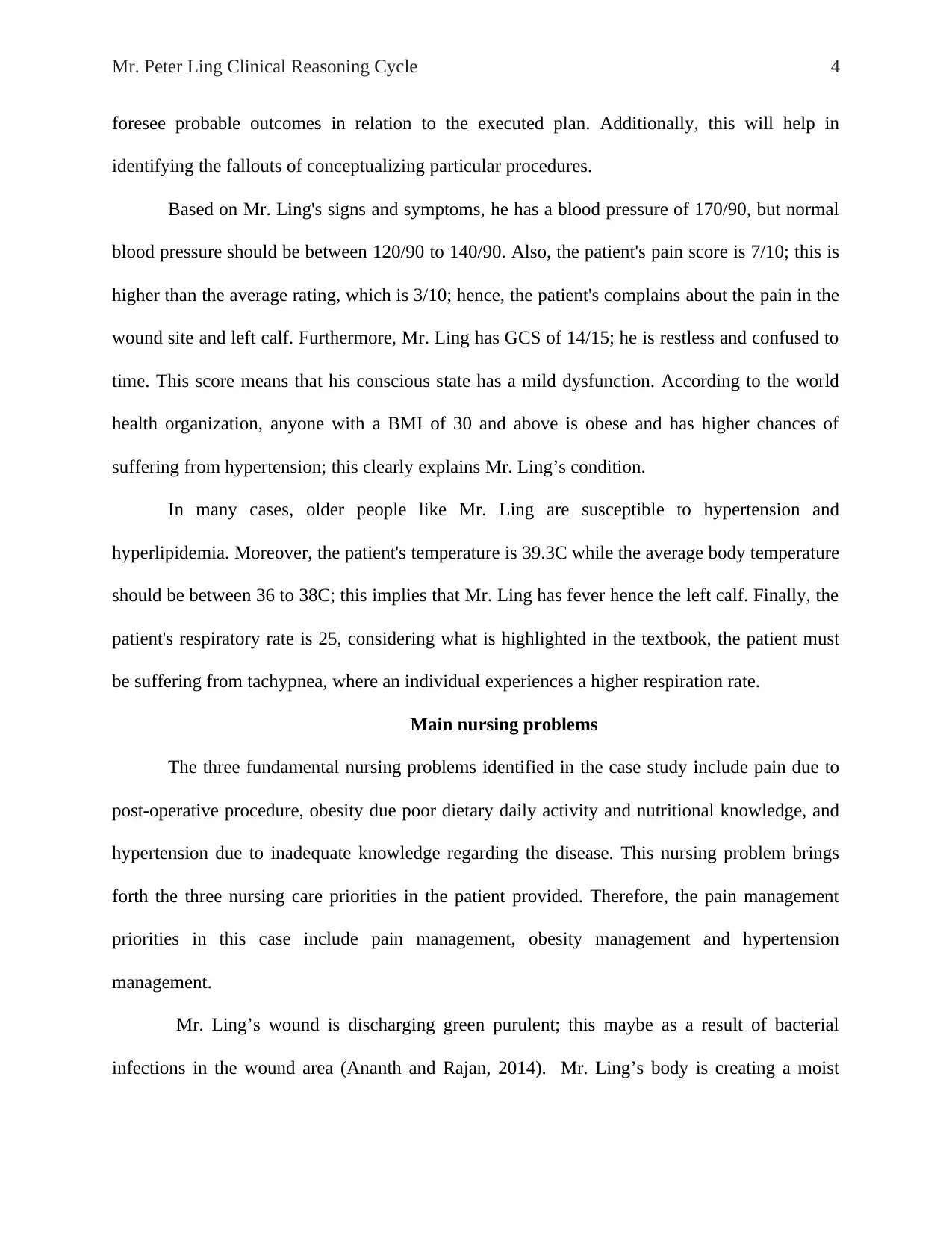
Mr. Peter Ling Clinical Reasoning Cycle 4
foresee probable outcomes in relation to the executed plan. Additionally, this will help in
identifying the fallouts of conceptualizing particular procedures.
Based on Mr. Ling's signs and symptoms, he has a blood pressure of 170/90, but normal
blood pressure should be between 120/90 to 140/90. Also, the patient's pain score is 7/10; this is
higher than the average rating, which is 3/10; hence, the patient's complains about the pain in the
wound site and left calf. Furthermore, Mr. Ling has GCS of 14/15; he is restless and confused to
time. This score means that his conscious state has a mild dysfunction. According to the world
health organization, anyone with a BMI of 30 and above is obese and has higher chances of
suffering from hypertension; this clearly explains Mr. Ling’s condition.
In many cases, older people like Mr. Ling are susceptible to hypertension and
hyperlipidemia. Moreover, the patient's temperature is 39.3C while the average body temperature
should be between 36 to 38C; this implies that Mr. Ling has fever hence the left calf. Finally, the
patient's respiratory rate is 25, considering what is highlighted in the textbook, the patient must
be suffering from tachypnea, where an individual experiences a higher respiration rate.
Main nursing problems
The three fundamental nursing problems identified in the case study include pain due to
post-operative procedure, obesity due poor dietary daily activity and nutritional knowledge, and
hypertension due to inadequate knowledge regarding the disease. This nursing problem brings
forth the three nursing care priorities in the patient provided. Therefore, the pain management
priorities in this case include pain management, obesity management and hypertension
management.
Mr. Ling’s wound is discharging green purulent; this maybe as a result of bacterial
infections in the wound area (Ananth and Rajan, 2014). Mr. Ling’s body is creating a moist
foresee probable outcomes in relation to the executed plan. Additionally, this will help in
identifying the fallouts of conceptualizing particular procedures.
Based on Mr. Ling's signs and symptoms, he has a blood pressure of 170/90, but normal
blood pressure should be between 120/90 to 140/90. Also, the patient's pain score is 7/10; this is
higher than the average rating, which is 3/10; hence, the patient's complains about the pain in the
wound site and left calf. Furthermore, Mr. Ling has GCS of 14/15; he is restless and confused to
time. This score means that his conscious state has a mild dysfunction. According to the world
health organization, anyone with a BMI of 30 and above is obese and has higher chances of
suffering from hypertension; this clearly explains Mr. Ling’s condition.
In many cases, older people like Mr. Ling are susceptible to hypertension and
hyperlipidemia. Moreover, the patient's temperature is 39.3C while the average body temperature
should be between 36 to 38C; this implies that Mr. Ling has fever hence the left calf. Finally, the
patient's respiratory rate is 25, considering what is highlighted in the textbook, the patient must
be suffering from tachypnea, where an individual experiences a higher respiration rate.
Main nursing problems
The three fundamental nursing problems identified in the case study include pain due to
post-operative procedure, obesity due poor dietary daily activity and nutritional knowledge, and
hypertension due to inadequate knowledge regarding the disease. This nursing problem brings
forth the three nursing care priorities in the patient provided. Therefore, the pain management
priorities in this case include pain management, obesity management and hypertension
management.
Mr. Ling’s wound is discharging green purulent; this maybe as a result of bacterial
infections in the wound area (Ananth and Rajan, 2014). Mr. Ling’s body is creating a moist
Paraphrase This Document
Need a fresh take? Get an instant paraphrase of this document with our AI Paraphraser

Mr. Peter Ling Clinical Reasoning Cycle 5
environment around the wound in an attempt to heal itself. Moreover, open injuries are highly
prevalent to infections compared to closed wounds; this makes the tissues swollen and painful. It
vividly explains the reason why Mr. Ling’s left calf is larger than the right one and painful.
Furthermore, in the clinical nursing cycle, it is fundamental to consider the primary symptoms of
the patient before handling the secondary problems. Therefore, it is fundamental to prioritize
pain assessment and management in the case provided.
Secondly, Mr. Ling displays signs of obesity. This is a fundamental problem that must be
managed in the nursing practice. Obesity is associated with plenty of adverse conditions like
diabetes type 2, hypertension, cancer, heart failure and respiratory disease. In the case provided,
the patient displays most of these diseases. This includes hypertension, respiratory disease and
heart failure. Therefore, there might be a great likelihood that such conditions are arising from
his obesity condition. However, it is irrational to neglect the fact that obesity originates from
poor lifestyle such as poor diet and lack of daily exercise. This means most of the patients
suffering from the disease lack knowledge about healthy lifestyle conditions. Hence, it is
imperative for registered nurses to prioritize obesity and educate patients regarding the self-care
programs for the disease.
Lastly, hypertension management is fundamental with respect to the patient provided.
Hypertension also results from poor lifestyle like poor nutrition and inadequate daily exercises.
Thus nurses have to educate patients’ about how to manage their conditions. Also, the fact that
Mr. Ling is agitated means that the patient might be absconding medications regarding the
management of her condition. This calls for stress management through proper advice and pain
management strategies for they have a great impact on the patient’s high blood pressure
condition. Furthermore, hypertension has a great implication to the development of heart failure.
environment around the wound in an attempt to heal itself. Moreover, open injuries are highly
prevalent to infections compared to closed wounds; this makes the tissues swollen and painful. It
vividly explains the reason why Mr. Ling’s left calf is larger than the right one and painful.
Furthermore, in the clinical nursing cycle, it is fundamental to consider the primary symptoms of
the patient before handling the secondary problems. Therefore, it is fundamental to prioritize
pain assessment and management in the case provided.
Secondly, Mr. Ling displays signs of obesity. This is a fundamental problem that must be
managed in the nursing practice. Obesity is associated with plenty of adverse conditions like
diabetes type 2, hypertension, cancer, heart failure and respiratory disease. In the case provided,
the patient displays most of these diseases. This includes hypertension, respiratory disease and
heart failure. Therefore, there might be a great likelihood that such conditions are arising from
his obesity condition. However, it is irrational to neglect the fact that obesity originates from
poor lifestyle such as poor diet and lack of daily exercise. This means most of the patients
suffering from the disease lack knowledge about healthy lifestyle conditions. Hence, it is
imperative for registered nurses to prioritize obesity and educate patients regarding the self-care
programs for the disease.
Lastly, hypertension management is fundamental with respect to the patient provided.
Hypertension also results from poor lifestyle like poor nutrition and inadequate daily exercises.
Thus nurses have to educate patients’ about how to manage their conditions. Also, the fact that
Mr. Ling is agitated means that the patient might be absconding medications regarding the
management of her condition. This calls for stress management through proper advice and pain
management strategies for they have a great impact on the patient’s high blood pressure
condition. Furthermore, hypertension has a great implication to the development of heart failure.

Mr. Peter Ling Clinical Reasoning Cycle 6
Therefore, nurses should consider the hypertension management since the patient in this case has
begun presenting symptoms of mild congestive heart failure.
Goals
The main objective of this phase is to outline the course of actions that will provide
corrective measures that can help to improve the patient's condition (Levette-Jones et al., 2014).
In Mr. Ling's case, the first goal is to reduce the pain score, which is currently at 7/10; this
insinuates that the patient's wound is excruciating. The second goal is to lower the patients
respiratory and pulse rate back to normal; this will eventually help to manage Mr. Ling's
hypertension condition. It is also fundamental to maintain the prescribed medication for his
hyperlipidemia condition. Additionally, it is significant to prevent treat his congestive heart
failure condition. Mr. Ling’s body temperature (39.3 degrees Celsius) must be brought back to
normal (36-37 degrees Celsius). It is also significant to raise the SpO2 reading above 95% so as
to minimize the likelihood of developing hypoxia (poor blood oxygenation). Lastly, the level of
hemoglobin concentration must also be brought back to normal.
Actions
Based on Mr. Ling’s situation, if the wound is not taken care of properly, there are higher
chances of pain persisting. Additionally, if he is not put on fluid, there are higher chances that he
may get shocked. Due to his increased pulse rate and respiratory rate, he will be given some
behavioral therapy that will help to reduce his stress and depression levels. Since the patient is
old and suffering from hypertension, high respiration, and pulse rate may result in difficulty in
breathing or even stroke (Van Diest et al. 2014). Cleaning the wound will significantly help to
reduce the bacterial infection and will also work in reducing the pain. With all these actions
taken carefully, even hemoglobin concentration would be brought back to normal.
Therefore, nurses should consider the hypertension management since the patient in this case has
begun presenting symptoms of mild congestive heart failure.
Goals
The main objective of this phase is to outline the course of actions that will provide
corrective measures that can help to improve the patient's condition (Levette-Jones et al., 2014).
In Mr. Ling's case, the first goal is to reduce the pain score, which is currently at 7/10; this
insinuates that the patient's wound is excruciating. The second goal is to lower the patients
respiratory and pulse rate back to normal; this will eventually help to manage Mr. Ling's
hypertension condition. It is also fundamental to maintain the prescribed medication for his
hyperlipidemia condition. Additionally, it is significant to prevent treat his congestive heart
failure condition. Mr. Ling’s body temperature (39.3 degrees Celsius) must be brought back to
normal (36-37 degrees Celsius). It is also significant to raise the SpO2 reading above 95% so as
to minimize the likelihood of developing hypoxia (poor blood oxygenation). Lastly, the level of
hemoglobin concentration must also be brought back to normal.
Actions
Based on Mr. Ling’s situation, if the wound is not taken care of properly, there are higher
chances of pain persisting. Additionally, if he is not put on fluid, there are higher chances that he
may get shocked. Due to his increased pulse rate and respiratory rate, he will be given some
behavioral therapy that will help to reduce his stress and depression levels. Since the patient is
old and suffering from hypertension, high respiration, and pulse rate may result in difficulty in
breathing or even stroke (Van Diest et al. 2014). Cleaning the wound will significantly help to
reduce the bacterial infection and will also work in reducing the pain. With all these actions
taken carefully, even hemoglobin concentration would be brought back to normal.
⊘ This is a preview!⊘
Do you want full access?
Subscribe today to unlock all pages.

Trusted by 1+ million students worldwide

Mr. Peter Ling Clinical Reasoning Cycle 7
Evaluation
As stipulated by Levette-Jones et al. (2014), this phase involves a re-evaluation of the
patient's cues and the current condition in order to determine the most effective nursing
interventions and whether the patient has improved. In Mr. Ling's case, lowering the pain from
the wound and lowering infections have proven to be an effective remedy for the patient. It has
not only improved the healing process but also lessened the pain experienced by the patient. The
pain level of the patient has been reduced to 3/10 after administering antibiotics and narcotic
drugs. This score ascertains that the pain has wholly been reduced. Additionally, wound
treatment and applying fluid have helped to reduce the pressure that the patient was initially
experiencing. Use of painkillers has also played a significant role in lowering pain and reducing
fever (Scuteri et al., 2018).
Administering drugs to control hypertension and hyperlipidemia have proven to be
effective in stabilizing the patient and ensuring a smooth route to the healing of the wound.
Moreover, the patient is responding well to diet following the fluid and roughages which were
given to the patient. All the interventions used by the nursing practitioners with the help of senior
doctors have ensured rejuvenation of Mr. Ling's health status. Cognitive-behavioral therapy
would also help to improve patient behavior and ensure better health status.
Conclusion
Clinical reasoning cycle is the best approach in handling and caring for the patients. It
will not only improve the patient outcomes, but it will also reduce the number of lawsuits filed
against health care providing institutions around the world. With respect to Mr. Ling’s status, it
is obvious that significant problems have to be handled. Most importantly, Mr. Ling’s presents
fundamental complications like hypertension, hyperlipidemia, mild congestive heart failure,
Evaluation
As stipulated by Levette-Jones et al. (2014), this phase involves a re-evaluation of the
patient's cues and the current condition in order to determine the most effective nursing
interventions and whether the patient has improved. In Mr. Ling's case, lowering the pain from
the wound and lowering infections have proven to be an effective remedy for the patient. It has
not only improved the healing process but also lessened the pain experienced by the patient. The
pain level of the patient has been reduced to 3/10 after administering antibiotics and narcotic
drugs. This score ascertains that the pain has wholly been reduced. Additionally, wound
treatment and applying fluid have helped to reduce the pressure that the patient was initially
experiencing. Use of painkillers has also played a significant role in lowering pain and reducing
fever (Scuteri et al., 2018).
Administering drugs to control hypertension and hyperlipidemia have proven to be
effective in stabilizing the patient and ensuring a smooth route to the healing of the wound.
Moreover, the patient is responding well to diet following the fluid and roughages which were
given to the patient. All the interventions used by the nursing practitioners with the help of senior
doctors have ensured rejuvenation of Mr. Ling's health status. Cognitive-behavioral therapy
would also help to improve patient behavior and ensure better health status.
Conclusion
Clinical reasoning cycle is the best approach in handling and caring for the patients. It
will not only improve the patient outcomes, but it will also reduce the number of lawsuits filed
against health care providing institutions around the world. With respect to Mr. Ling’s status, it
is obvious that significant problems have to be handled. Most importantly, Mr. Ling’s presents
fundamental complications like hypertension, hyperlipidemia, mild congestive heart failure,
Paraphrase This Document
Need a fresh take? Get an instant paraphrase of this document with our AI Paraphraser
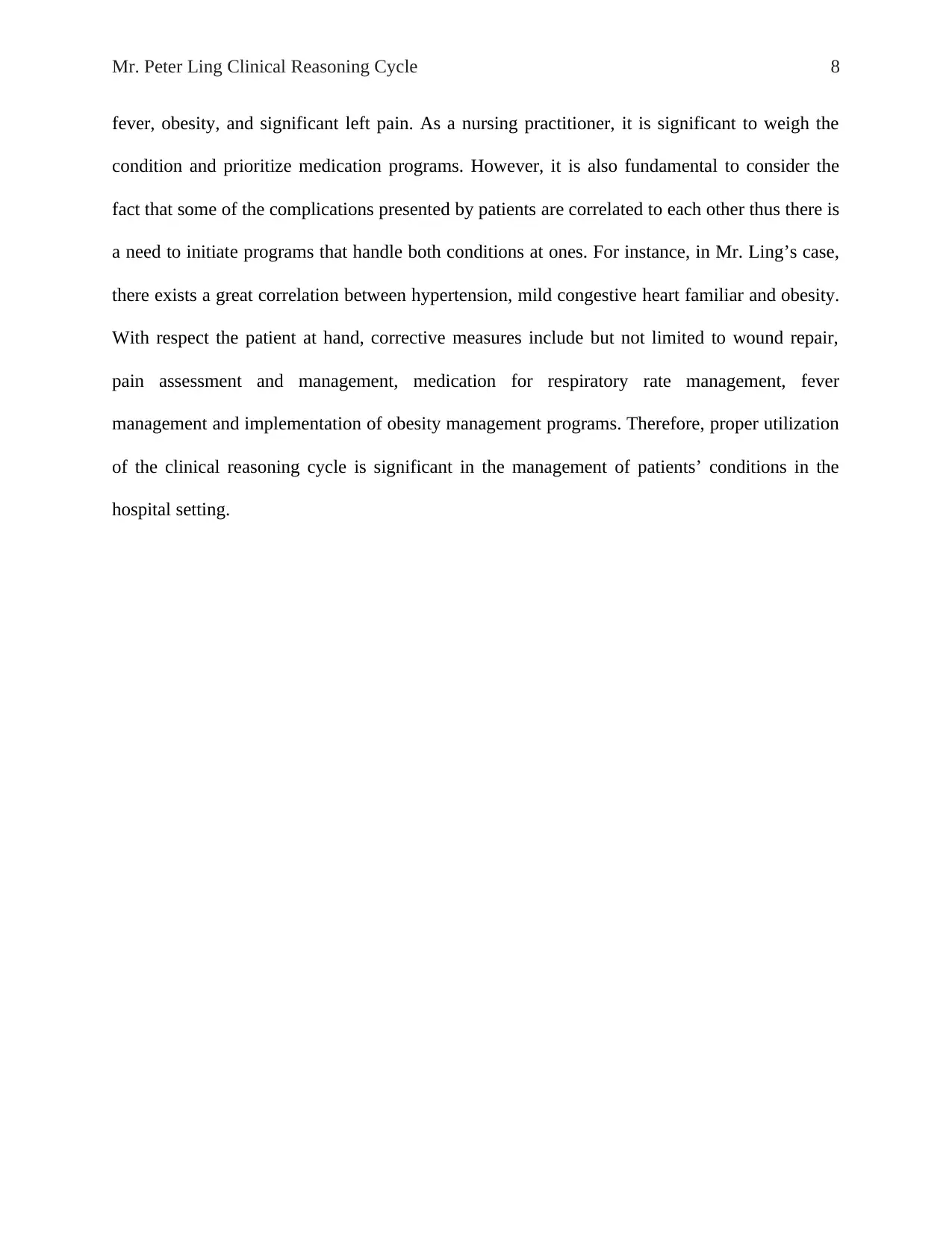
Mr. Peter Ling Clinical Reasoning Cycle 8
fever, obesity, and significant left pain. As a nursing practitioner, it is significant to weigh the
condition and prioritize medication programs. However, it is also fundamental to consider the
fact that some of the complications presented by patients are correlated to each other thus there is
a need to initiate programs that handle both conditions at ones. For instance, in Mr. Ling’s case,
there exists a great correlation between hypertension, mild congestive heart familiar and obesity.
With respect the patient at hand, corrective measures include but not limited to wound repair,
pain assessment and management, medication for respiratory rate management, fever
management and implementation of obesity management programs. Therefore, proper utilization
of the clinical reasoning cycle is significant in the management of patients’ conditions in the
hospital setting.
fever, obesity, and significant left pain. As a nursing practitioner, it is significant to weigh the
condition and prioritize medication programs. However, it is also fundamental to consider the
fact that some of the complications presented by patients are correlated to each other thus there is
a need to initiate programs that handle both conditions at ones. For instance, in Mr. Ling’s case,
there exists a great correlation between hypertension, mild congestive heart familiar and obesity.
With respect the patient at hand, corrective measures include but not limited to wound repair,
pain assessment and management, medication for respiratory rate management, fever
management and implementation of obesity management programs. Therefore, proper utilization
of the clinical reasoning cycle is significant in the management of patients’ conditions in the
hospital setting.

Mr. Peter Ling Clinical Reasoning Cycle 9
References
Ananth, A., & Rajan, S. (2014). Isolation and screening of pathogenic bacteria from wound
infections. Int J Curr Pharm Res, 6(3), 15-17.
James, P. A., Oparil, S., Carter, B. L., Cushman, W. C., Dennison-Himmelfarb, C., Handler,
J., ... & Smith, S. C. (2014). 2014 evidence-based guideline for the management of high
blood pressure in adults: a report from the panel members appointed to the Eighth Joint
National Committee (JNC 8). Jama, 311(5), 507-520.
Levett-Jones, T., & Bourgeois, S. (2015). The clinical placement-e-book: An essential guide for
nursing students. Elsevier Health Sciences.
Levett-Jones, T., & Lapkin, S. (2014). A systematic review of the effectiveness of simulation
debriefing in health professional education. Nurse education today, 34(6), e58-e63.
Liaw, S. Y., Zhou, W. T., Lau, T. C., Siau, C., & Chan, S. W. C. (2014). An interprofessional
communication training using simulation to enhance safe care for a deteriorating
patient. Nurse Education Today, 34(2), 259-264.
Makary, M. A., & Daniel, M. (2016). Medical error—the third leading cause of death in the
US. Bmj, 353, i2139.
Scuteri, A., Rovella, V., Fegatelli, D. A., Tesauro, M., Gabriele, M., & Di Daniele, N. (2018).
An operational definition of SHATS (Systemic Hemodynamic Atherosclerotic
Syndrome): Role of arterial stiffness and blood pressure variability in elderly
hypertensive subjects. International journal of cardiology, 263, 132-137.
References
Ananth, A., & Rajan, S. (2014). Isolation and screening of pathogenic bacteria from wound
infections. Int J Curr Pharm Res, 6(3), 15-17.
James, P. A., Oparil, S., Carter, B. L., Cushman, W. C., Dennison-Himmelfarb, C., Handler,
J., ... & Smith, S. C. (2014). 2014 evidence-based guideline for the management of high
blood pressure in adults: a report from the panel members appointed to the Eighth Joint
National Committee (JNC 8). Jama, 311(5), 507-520.
Levett-Jones, T., & Bourgeois, S. (2015). The clinical placement-e-book: An essential guide for
nursing students. Elsevier Health Sciences.
Levett-Jones, T., & Lapkin, S. (2014). A systematic review of the effectiveness of simulation
debriefing in health professional education. Nurse education today, 34(6), e58-e63.
Liaw, S. Y., Zhou, W. T., Lau, T. C., Siau, C., & Chan, S. W. C. (2014). An interprofessional
communication training using simulation to enhance safe care for a deteriorating
patient. Nurse Education Today, 34(2), 259-264.
Makary, M. A., & Daniel, M. (2016). Medical error—the third leading cause of death in the
US. Bmj, 353, i2139.
Scuteri, A., Rovella, V., Fegatelli, D. A., Tesauro, M., Gabriele, M., & Di Daniele, N. (2018).
An operational definition of SHATS (Systemic Hemodynamic Atherosclerotic
Syndrome): Role of arterial stiffness and blood pressure variability in elderly
hypertensive subjects. International journal of cardiology, 263, 132-137.
⊘ This is a preview!⊘
Do you want full access?
Subscribe today to unlock all pages.

Trusted by 1+ million students worldwide
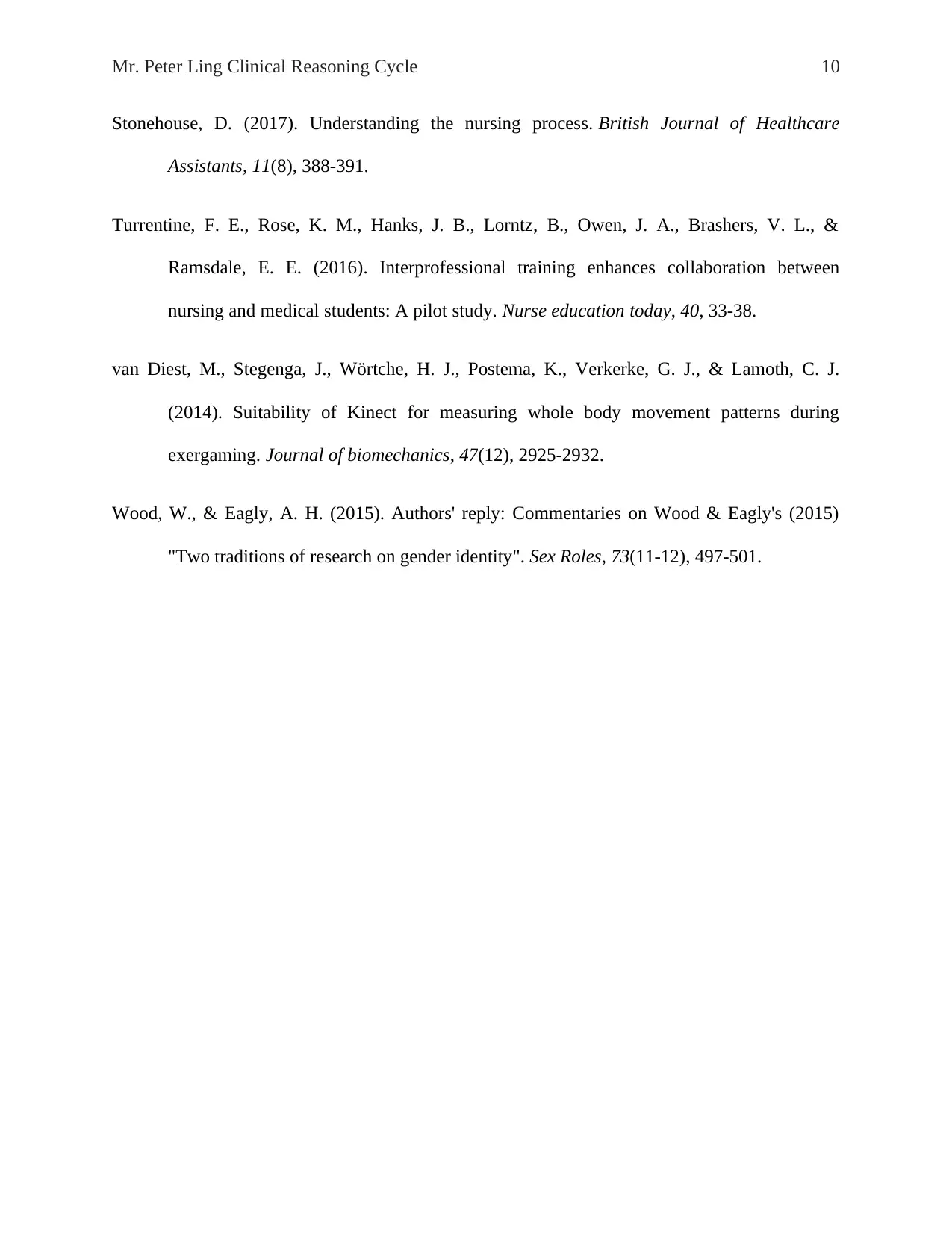
Mr. Peter Ling Clinical Reasoning Cycle 10
Stonehouse, D. (2017). Understanding the nursing process. British Journal of Healthcare
Assistants, 11(8), 388-391.
Turrentine, F. E., Rose, K. M., Hanks, J. B., Lorntz, B., Owen, J. A., Brashers, V. L., &
Ramsdale, E. E. (2016). Interprofessional training enhances collaboration between
nursing and medical students: A pilot study. Nurse education today, 40, 33-38.
van Diest, M., Stegenga, J., Wörtche, H. J., Postema, K., Verkerke, G. J., & Lamoth, C. J.
(2014). Suitability of Kinect for measuring whole body movement patterns during
exergaming. Journal of biomechanics, 47(12), 2925-2932.
Wood, W., & Eagly, A. H. (2015). Authors' reply: Commentaries on Wood & Eagly's (2015)
"Two traditions of research on gender identity". Sex Roles, 73(11-12), 497-501.
Stonehouse, D. (2017). Understanding the nursing process. British Journal of Healthcare
Assistants, 11(8), 388-391.
Turrentine, F. E., Rose, K. M., Hanks, J. B., Lorntz, B., Owen, J. A., Brashers, V. L., &
Ramsdale, E. E. (2016). Interprofessional training enhances collaboration between
nursing and medical students: A pilot study. Nurse education today, 40, 33-38.
van Diest, M., Stegenga, J., Wörtche, H. J., Postema, K., Verkerke, G. J., & Lamoth, C. J.
(2014). Suitability of Kinect for measuring whole body movement patterns during
exergaming. Journal of biomechanics, 47(12), 2925-2932.
Wood, W., & Eagly, A. H. (2015). Authors' reply: Commentaries on Wood & Eagly's (2015)
"Two traditions of research on gender identity". Sex Roles, 73(11-12), 497-501.
1 out of 10
Related Documents
Your All-in-One AI-Powered Toolkit for Academic Success.
+13062052269
info@desklib.com
Available 24*7 on WhatsApp / Email
![[object Object]](/_next/static/media/star-bottom.7253800d.svg)
Unlock your academic potential
Copyright © 2020–2025 A2Z Services. All Rights Reserved. Developed and managed by ZUCOL.





